

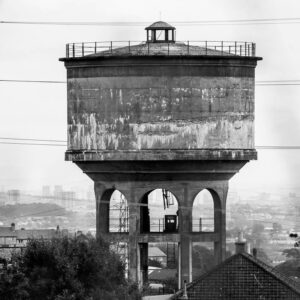
making the movie:
badlands
Out of the blue, last summer brought an email from a man claiming to own half of the Cochno Stone, the most elusive of all the places mentioned by Harry Bell in his Gazetteer of Sites. My search for the Cochno, or Druid Stone, features in an earlier blog. The stone, arguably the most significant cup-and-ring marked stone in existence, became something of a lost cause for me.
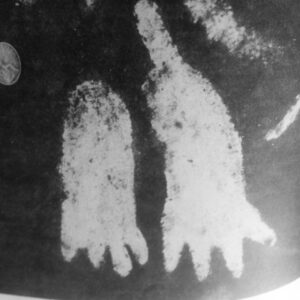
Measuring 55 by 35 feet, its surface carved with a series of concentric rings, a crossed circle (also known as a sun wheel) and perhaps even more curiously, a set of four-toed ‘footprints’, the stone was buried under a metre of soil in 1964 to deter vandals and for almost fifty years has remained hidden. What wouldn’t I give to see it?
My curiosity piqued, a phone call later, Dave invited me to visit. I didn’t need asking twice. Arriving at his house on a rain-swept Friday afternoon, I was welcomed by Dave and Elaine, his wife of almost 51 years, who abandoned her needlework to ply me with coffee and home baking. It’s bashert, she said, commenting on my visit – bashert being the Yiddish term for destiny or fate.
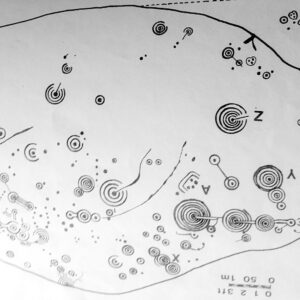
Dave, enthused by our shared interest in the Cochno Stone, handed me a dog-earred copy of The Prehistoric Rock Art of Southern Scotland written by Ronald. B. W. Morris who, as he told me, arrived uninvited on his doorstep. Reluctant to loan his copy (abused by another enthusiast), Dave suggested I could track down my own. Which I did, only to discover two used copies on sale on Amazon at £80 and £125 respectively.
Dave offered several documents confirming his half-ownership. Among them, an aerial photograph taken decades ago reveals the site of the stone, situated on the boundary of his three-acre garden. But what exactly does he have in mind? As co-owner of such a beautiful and occult artefact, Dave tells me he would love to see the stone uncovered – but where to start?
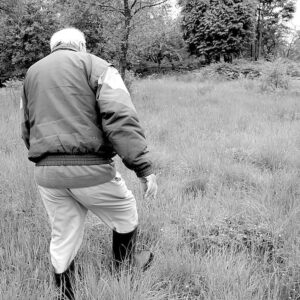
In borrowed wellies, I followed Dave outside as he guided me through his vast garden towards a dry stone wall – the boundary between the garden and the stone. Dave stood aside as I waded through dense bracken and tall grasses, arriving at a set of vertical scaffolding poles woven with chicken wire. Behind the wall, the poles and the wire – not to mention the metre of soil – lies the Cochno Stone. I would defy anyone to find it because for weeks I looked for its approximate site, unaware it lay in both public and private land.
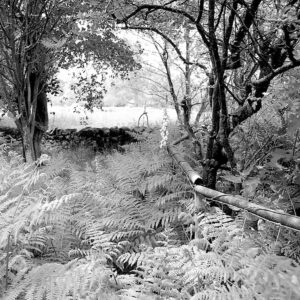
After viewing the site from Dave’s land, he suggested we see the other, ‘public’ side of the Cochno Stone by walking a few hundred yards on the public road outside his land. He pointed out a rusted gate – unaccompanied by any wall, railing or fence. Close to Auchnacraig it’s a place clearly overlooked by West Dunbartonshire Council in spite of being ‘wild’ landscaped in recent years.
Having agreed to contact the relevant players – namely the council and Historic Scotland, we part company. Over the following weeks, after many calls and emails, I persuade Historic Scotland to make a site visit to discuss the possibility of an excavation. Excited, I email Dave with the news, deflated when I hear nothing. Several weeks pass until, one September day, I receive a reply. However it’s not what I expected. I don’t learn the actual date but according to his son, Dave passed away suddenly.
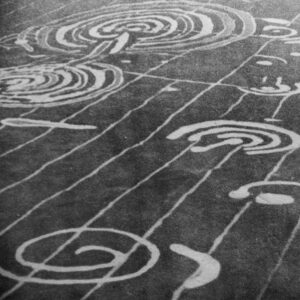
There are moments in one’s life when words fail. That afternoon I sat silently in my shed, gazing at a photograph of the Stone, its carved surface filled with chalk, taken during the excavation prior to its burial in 1964. I thought of Dave and his wife and how, in a few short hours, I learned so much about their lives – how Dave’s engineering career brought him from the Midlands to Clydebank and the Singer Factory, and how he and Elaine had two sons and how during their retirement they had ventured up the Amazon.
I return to the area in brilliant sunshine, the ground frozen solid. I’m shooting for one of Mary Ross’ episodes where she attempts to locate Novo’s original owner in Faifley but I have no shots that truly identify the place, hence the visit. Ironic given that I made so many trips to Duncolm and Cochno at the expense of this small housing scheme, situated close to Hardgate, Edinbarnet and Duntocher on the city’s edgelands.
What’s striking about the entire area are the pylons planted firmly, dwarfing both the tenement blocks and low rises. An accident of planning, I wonder? It is eerily quiet as I take my shots – only a postman and two small children pass me. Close to the bus terminus I notice a sculpture of a mother and child constructed of fused cable.
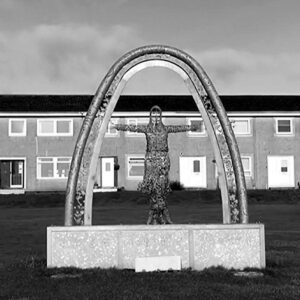
Beyond the terminus, I arrive at a patch of grass and a strange pyramid built of granite setts and rough mortar. I look at it from several angles, trying to fathom its purpose. At its base lie the remains of a recent campfire and curiously, in addition to the usual detritus, a pile of blackened food cans, suggesting less a neighbourly barbeque than a Hooverville kitchen but in reality it’s probably just the local weans escaping from the microwave.
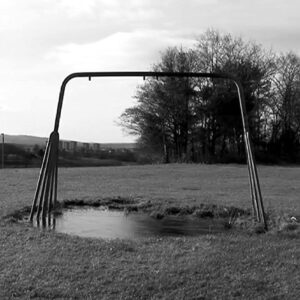
Musing on the absence of swings in the swingpark, I’m alerted by a trio of horses and riders taking a shortcut through the scheme in the direction of Hardgate. Plainly I’m no longer in the city, although Faifley could be mistaken for virtually any Glasgow scheme. Only it’s not. It lies on that edge of the urban and rural and, as my husband informs me, is a far more dangerous place to be than the city – it is, he’s convinced, the Badlands, where people hold their privacy – and their deviance – dear. As if on cue, moments later, as we pause by the derelict Cochno watertower we’re accosted by two fat women in a van. “This is private land” pipes up one of them. Me – “Where’s the sign?” Her – “I’m phoning the police.”. Me – “Do that.” There’s a momentary standoff as she toys with her phone but I know she won’t make the call. She drives off in a rage.
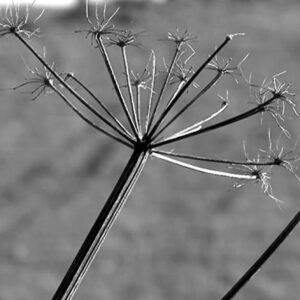
My final destination is as close as I dare to the site of the Cochno Stone. In the grounds of Dave and Elaine’s house I spot a car, so I decide to keep a respectful distance. Instead I take the necessary shots – of the rusty gate on the edge of their land – and move on. I remind myself we’re in the dead of winter and there is nothing much to see, knowing that a few yards away the Cochno Stone lies buried, prompting the thought that it may elude me forever. As I leave I recall Elaine’s words – it’s bashert.
I’m really enjoying this fresh burst of blogs from you May, keep it up.
I’d also love to see the film.
Thanks Ewan – lovely to hear from you. Glad you’re reading my blog. I’m finishing the edit in time for my GFF screening on the 23rd. Must admit I’m feeling a bit nervous because there’s been absolutely no budget for it. We’ll see who turns up!
All the best,
May
Thanks for the info Tam – once I get the film finished I’ll take a trip and check out your sites. I always had the feeling old Harry missed a trick or two in the Secret Geometry.
It was a great shame about the Cochno Stone – I was planning to make a documentary about it being excavated. Dave’s death came as a real shock to me – he was such a enthusiast.
cheers,
May
Hi May. Sad story about Dave. I never knew the man but am sure he was glad to show you the site before he left us and also glad that someone was showing a genuine interest in the site for the right reasons. The diagram looks very interesting indeed. Is there any thought on what it the markings represent? They often make out these things are astronomical but they look more topographical to me, a bit like the aboriginal rock paintings Harry Bell mentions in his book.
Anyway, enjoying you updates.
I have another site you might want to have a look at. Its the Clochoderick Stone near Lochwinnoch. As far as I can make out there is a line from Govan Old through the grounds of Paisley Abbey past Johnstone Castle and on to the stone itself. The line is not quite accurate enough so far, hey but its worth a visit to see this muckle big stane sitting alone in a field, and you can climb up it too. I still have some work to do on it but the notion is supported slightly by the fact that it is said to be the grave marker of Rhydderch, 6th century British king who had strong connections to Govan, Dumbarton and Cadzow. I will keep you posted but I am sure Harry B. would have considered including it on his map or would have mentioned it if he indeed knew of its existence.
Say hi to all my mates at Sunny Govan next time you are down there. Awthebest. Tam.
I used to stay in Cochno Road & heard stories of this stone. Have you seen this: https://www.scotsman.com/lifestyle/heritage/5000-year-old-cochno-stone-carving-may-be-revealed-1-3479326
best wishes
Thanks Gerry – I did – and I blogged about it last night! Seems there’s a lot of interest in it – in fact there’s a Facebook campaign to have the Stone unearthed for the first time in 50 years –
https://www.facebook.com/groups/uncovercochnostone/809018245799550/?notif_t=group_comment_reply
– I’ve got mixed feelings about it – as much as I’d like to see the Stone – I wanted to make a film about it a few years ago – I’d hate to see it become a tourist destination. Mind you, there’s a large fan base for Rock Art, and it might put Cochno on the map!
All the best,
May
Hello May, my name is Tony Burns. I was born and raised in Sunny Faifley 46 years ago,where My Mum was also born and raised.My Mum was one of the first people to live in Faifley at the time. When we were growing up my Mum would take us to all the ring marked rocks that she knew of, and there are many. I have just found your site,and have’t read much. YET! but you don’t know what it means to me to find that someone is looking into the things that have been going on regarding the Ring Stones and Cup Markings. I also don’t know what has lead you to there discovery,,,cos i haven’t got that far into your site.”I am not much good at this typing and i am soooo excited at what i have just been reading” but i will carry on just hoping that you can make sense of my ramblings. In your photos of Faifley, when you took a walk to the park… there was many more there. as you look past the photo of the swings ter is a small outcrop of rocks they were marked, also why the BIG CONCRETE STRUCTURE ???, to the left of your swing photo there was a big one over towards the road. but it was covered over when they built the park. “IT did have swings once”. There were many in and around the park. some you can still see if you know where to look. There are many more around the hills surrounding Faifley. Not sure if you know about the Druid Village or Temple that was found. Also I heard that there was also a burial are found. Both sites would be on the A82. OK i am of to read more..Take care Tony.
Thanks for getting in touch, Tony. If you read the blog, you’ll soon learn why Faifley and the Cochno Stone feature in the project. I was in the area recently, visiting Elaine Marks – half of the Cochno, or Druid Stone lies buried in her garden. Understandably she’s reluctant for it to be excavated, as some have suggested, but since the owners of the other half of the Stone, West Dunbartonshire Council, don’t seem interested, I expect it will lie undisturbed for years to come. I’m well aware of other cup-and-ring stones in the area – it’s a fascinating phenomenon – but I admit I hadn’t heard of the Druid Village/Temple until recently. Thanks for visiting the site!
All the best,
May
Interesting.. Faifley is certainly not the bad lands, its full of community. The big concrete structure i assume you refer to was at one point a slide in the park which has all been redone. Not sure I really like the tone set about the “scheme” that I live in.. but anyway..
The stone, many would love to see it uncovered, I always thought it looked like a map of the hills, or a map of something with the rings being the hill peaks. Who knows its interesting and don’t think anyone has properly researched it.
Thanks for taking the time to comment, Rebecca. You’re free to criticise my take on Faifley, which was written 10 years ago but I stand by my description, which I assure you wasn’t intended to be derogatory. As for the Cochno Stone – you may be aware that the stone was uncovered in 2016 by Dr. Kenny Brophy and his team from Glasgow University Archaeology Department in association with Factum Arte. This happened only because I raised awareness of the stone and blogged about it here. I’m pleased to tell you that there has been considerable research into the stone by Dr. Brophy and others in the last decade.